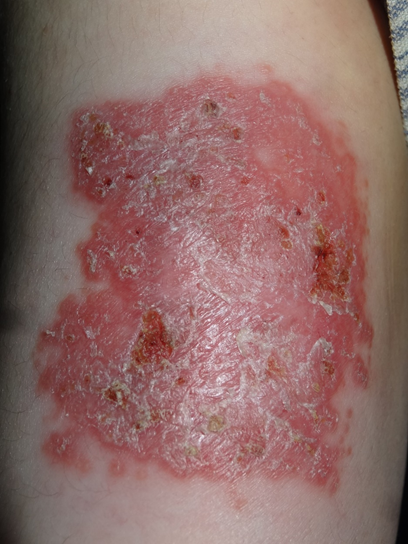Journal of
eISSN: 2574-9943


Case Series Volume 8 Issue 3
1Department of Dermatology, Faculty of Medicine and Health Sciences, Sana’a University, Sana’a,Yemen
2Department of Conservative Dentistry, Faculty of Dentistry, Sana’a University, Sana’a,Yemen
Correspondence: Mohammad Ali Alshami, Department of Dermatology, Faculty of Medicine and Health Sciences, Sana’a University, Sana’a,Yemen, Tel +967-733760082
Received: September 12, 2024 | Published: September 26, 2024
Citation: Alshami MA, Alshami AM, Alshami HM. Rectangular single-plaque psoriasis: a report of two cases in Yemen. J Dermat Cosmetol. 2024;8(3):94-95. DOI: 10.15406/jdc.2024.08.00274
Psoriasis is a commonly occurring immune-mediated chronic dermatosis that affects 2–3% of the world's population. Patients usually present with multiple plaques distributed across the trunk. In rare cases, patients have a few plaques, and in rarer cases, patients have plaques on just one side of the body. Psoriasis manifesting as a single plaque is extremely rare, with only one case reported to date. Plaques are usually round or oval; however, to the best of our knowledge, no case of a rectangular plaque has been reported. Herein, we present two cases of rectangular, single-plaque psoriasis: one on the right upper arm of a female patient and another on the right buttock of a male patient. In both cases, the diagnosis was based on typical clinical presentations. The patients were treated with topical clobetasol ointment, which resulted in excellent improvement. The present case series highlights the importance of considering single-plaque psoriasis as part of the differential diagnosis when a scaly plaque presents as a solitary lesion.
Keywords: male, female, clobetasol ointment, arm, buttock, psoriasis, skin diseases, skin abnormalities
Psoriasis is a common immune-mediated chronic dermatosis that affects 2–3% of the world's population.1 It is clinically classified according to the type of lesion: plaque, guttate, or pustular.2 Plaques can be generalized or localized, symmetrical or asymmetrical, and unilateral or bilateral.3 Psoriasis presenting as a single plaque is extremely rare, with only one case reported in the literature. To the best of our knowledge, no previous case of a single rectangular-shaped plaque has been reported.4 Here, we present the cases of a 22-year-old Yemeni woman and a 45-year-old Yemeni man; both patients were diagnosed with rectangular single-plaque psoriasis based on typical clinical findings, and the male patient also showed prominent histological features.
Case 1
A 23-year-old woman with skin type III presented with a single, itchy, rectangular, scaly plaque on the right upper arm for 3 weeks. Cutaneous examination revealed a 6×7-cm salmon-red plaque covered with silvery scales on the anterolateral aspect of the right upper arm (Figure 1a & Figure 1b). She was diagnosed with single-plaque psoriasis based on the typical clinical features. Treatment with a topical clobetasol ointment reduced the erythema and scales after 1 week.

Figure 1a Case 1. Anterior view of the volar aspect of the right upper arm. Single rectangular salmon-red psoriatic plaque covered with silvery scales.

Figure 1b Case 2. A close-up view of the salmon-red, almost rectangular psoriatic plaque covered with silvery scales. Some areas are covered with scratch-induced hemorrhagic crusts.
Case 2
A 45-year-old man with skin type V presented with a severely itchy plaque on the right buttock that persisted for 5 months. Cutaneous examination revealed the presence of a brown 8×9-cm rectangular plaque covered with silvery scales on the right buttock (Figure 1c & Figure 1d). To confirm the diagnosis, a 3-mm punch biopsy was obtained from the plaque and examined, revealing features typical of plaque psoriasis. Based on the clinical and histological features of the lesion, the patient was diagnosed with single-plaque psoriasis. Treatment with topical clobetasol ointment was initiated, resulting in a reduction in itching, scales, and thickness of the plaque after 1 week of treatment.
Patients with psoriasis have many symptoms that can mimic other skin diseases, thus presenting diagnostic challenges.3 When assessing a single psoriatic plaque, a wide range of potential diagnoses should be ruled out until a correct diagnosis is reached. Treatment should be tailored to the type, location, and extent of the psoriatic lesions, as well as the patient's age and any contraindications to medication.4 Therapeutic options include topical and systemic treatments, which may be administered orally or parenterally.
The present case series highlights the importance of considering single-plaque psoriasis as part of the differential diagnosis when a scaly plaque presents as a solitary lesion.
None.
None.
The authors declare no conflict of interest.

©2024 Alshami, et al. This is an open access article distributed under the terms of the, which permits unrestricted use, distribution, and build upon your work non-commercially.